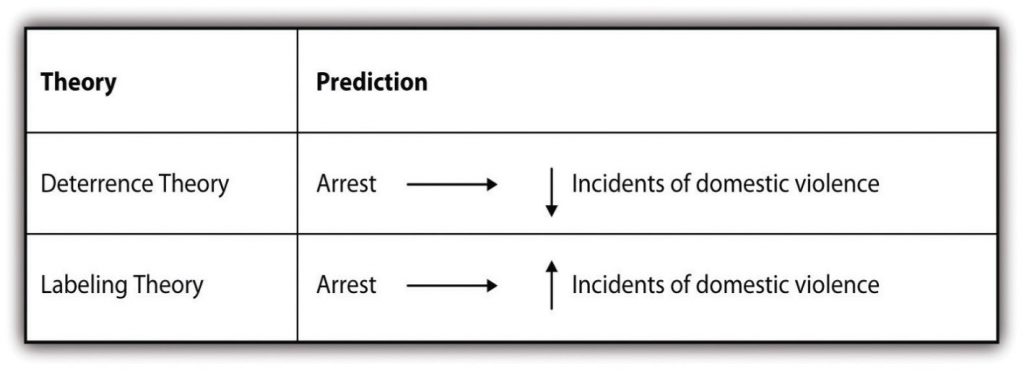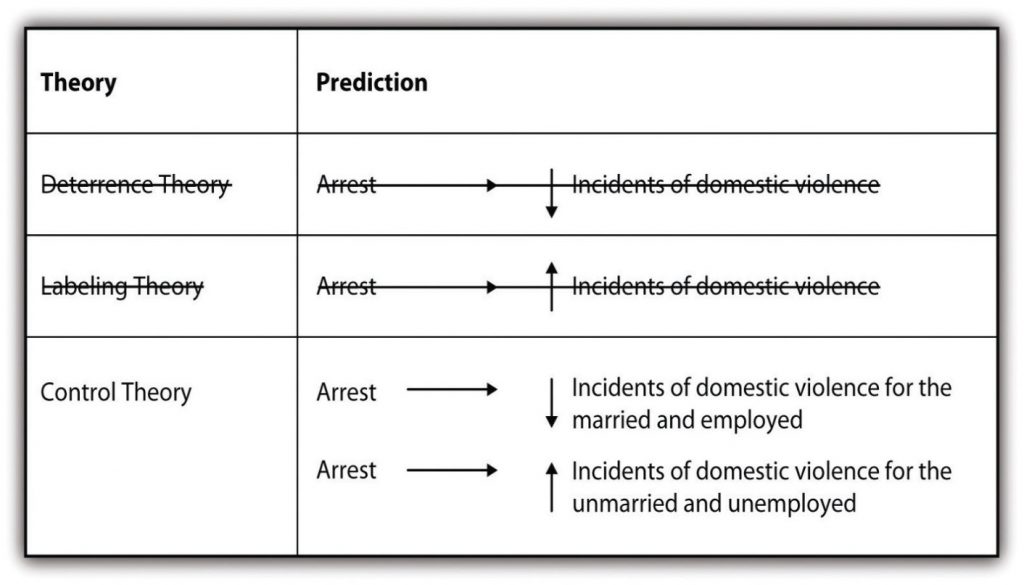Approaches to Research
There are a few questions one has to ask themselves about their research ideas before they ever start putting together a plan for collecting data. These range from the type of reasoning they’re using to the goal of the study to the extent to which they expect to show causality in their data or generalize their results. Let’s explore each of these in turn.
Inductive and Deductive Reasoning
Theory structures and informs social research. Conversely, social research structures and informs theory. Students become aware of the reciprocal relationship between theory and research when they consider the relationships between the two in inductive and deductive approaches. In both cases, theory is crucial but the relationship between theory and research differs for each approach.
Inductive and deductive approaches to research are quite different, but they can also be complementary. Let’s start by looking at each one and how they differ from one another. Then we’ll move on to thinking about how they complement one another.
Inductive Approach
When a researcher utilizes an inductive approach, they begin by collecting data that is relevant to their topic of interest. Once a substantial amount of data has been collected, the researcher will take a break from data collection to step back and get a bird’s eye view of their data. At this stage, the researcher looks for patterns in the data, working to develop a theory that could explain those patterns. Thus, when researchers take an inductive approach, they start with a set of observations and then they move from those particular experiences to a more general set of propositions about those experiences. In other words, they move from data to theory, or from the specific to the general. The figure below outlines the steps involved with an inductive approach to research.

Let’s Break it Down
Show
Inductive Approach
In simple terms:
Inductive reasoning involves starting with observations and then looking for patterns to build a general idea or theory.
It’s like noticing something happening over and over and then making a conclusion based on that.
Example:
A researcher interviews several teens and notices that those who spend more time on social media often mention feeling anxious.
They didn’t start with a theory—they just paid attention, looked for patterns, and came up with an idea:
“Maybe heavy social media use is linked to anxiety.”
That’s inductive reasoning—starting small (observations) and building up (a theory).

* This image was created using ChatGPT; however, the concept, design direction, and creative vision were conceived by Dr. Knight.
Dr. Christie Knight
There are many good examples of inductive research, but we’ll look at just a few here. One fascinating study in which the researchers took an inductive approach is Katherine Allen, Christine Kaestle, and Abbie Goldberg’s (2011) study of how boys and young men learn about menstruation. To understand this process, Allen and her colleagues analyzed the written narratives of 23 young men in which the men described how they learned about menstruation, what they thought of it when they first learned about it, and what they think of it now. By looking for patterns across all 23 men’s narratives, the researchers were able to develop a general theory of how boys and young men learn about this aspect of girls’ and women’s biology. They conclude that sisters play an important role in boys’ early understanding of menstruation, that menstruation makes boys feel somewhat separated from girls, and that as they enter young adulthood and form romantic relationships, young men develop more mature attitudes about menstruation. Note how this study began with the data—men’s narratives of learning about menstruation—and tried to develop a theory.
In another inductive study, Kristin Ferguson and colleagues (Ferguson, Kim, & McCoy, 2011) analyzed empirical data to better understand how best to meet the needs of young people who are experiencing homelessness. The authors analyzed data from focus groups with 20 young people at a homeless shelter. From this data they developed a set of recommendations for those interested in applied interventions that serve youth who are experiencing homelessness. The researchers also developed hypotheses for people who might wish to conduct further investigation of the topic. Though Ferguson and her colleagues did not test the hypotheses that they developed from their analysis, their study ends where most deductive investigations begin: with a theory and a hypothesis derived from that theory.
Deductive Approach
Researchers taking a deductive approach will start with a compelling social theory and then test its implications with data. In other words, they utilize the same steps as inductive research, but they will reverse the order, moving from general to more specific levels. Deductive research approach is most associated with scientific investigation. The researcher studies what others have done, reads existing theories of whatever phenomenon they are studying, and then tests hypotheses that emerge from those theories. The figure below outlines the steps involved with a deductive approach to research.

Let’s Break it Down
Show
Deductive Approach
In simple terms:
Deductive reasoning involves starting with a general idea or theory and then looking for specific examples or data to determine whether it’s true.
It’s like saying: “If this theory is correct, then I should see this happen.”
Then you go test it.
Example:
Suppose a researcher starts with the theory:
“People who exercise regularly have lower stress.”
Deductive reasoning means the researcher uses this big idea to make a specific prediction:
“If I ask people who exercise every week about their stress levels, they should report less stress than people who don’t exercise.”
So, the researcher surveys two groups—regular exercisers and non-exercisers—to see if the theory holds up.

* This image was created using ChatGPT; however, the concept, design direction, and creative vision were conceived by Dr. Knight.
Dr. Christie Knight
Although not all social science researchers utilize a deductive approach, there are some excellent, recent examples of deductive research. We’ll take a look at a couple of those next.
In a study of US law enforcement responses to hate crimes, Ryan King and colleagues (King, Messner, & Baller, 2009) hypothesized that law enforcement’s response would be less vigorous in areas of the country that had a stronger history of racial violence. The authors developed their hypothesis from their reading of prior research and theories on the topic. They tested the hypothesis by analyzing data on states’ lynching histories and hate crime responses. Overall, the authors found support for their hypothesis. One might associate this research with critical theory.
In another recent deductive study, Melissa Milkie and Catharine Warner (2011) studied the effects of different classroom environments on first graders’ mental health. Based on prior research and theory, Milkie and Warner hypothesized that negative classroom features, such as a lack of basic supplies and even heat, would be associated with emotional and behavioral problems in children. One might associate this research with systems theory. The researchers found support for their hypothesis, demonstrating that policymakers should be more attentive to the mental health outcomes of children’s school experiences, just as they track academic outcomes (American Sociological Association, 2011).
Complementary Approaches
While inductive and deductive approaches to research seem quite different, they can be rather complementary. In some cases, researchers will plan for their study to include multiple components, one inductive and the other deductive. In other cases, a researcher might begin their study planning to utilize only one approach but then discover along the way that the other approach is needed to help illuminate findings. Here is an example of each such case.
The original author of the textbook from which this textbook is adapted, Dr. Amy Blackstone, relates a story about her collaborative research on sexual harassment.
We began the study knowing that we would like to take both a deductive and an inductive approach in our work. We therefore administered a quantitative survey, the responses to which we could analyze in order to test hypotheses, and also conducted qualitative interviews with a number of the survey participants. The survey data were well suited to a deductive approach; we could analyze those data to test hypotheses that were generated based on theories of harassment. The interview data were well suited to an inductive approach; we looked for patterns across the interviews and then tried to make sense of those patterns by theorizing about them.
For one paper (Uggen & Blackstone, 2004), we began with a prominent feminist theory of the sexual harassment of adult women and developed a set of hypotheses outlining how we expected the theory to apply in the case of younger women’s and men’s harassment experiences. We then tested our hypotheses by analyzing the survey data. In general, we found support for the theory that posited that the current gender system, in which heteronormative men wield the most power in the workplace, explained workplace sexual harassment—not just of adult women but of younger women and men as well. In a more recent paper (Blackstone, Houle, & Uggen, 2006), we did not hypothesize about what we might find but instead inductively analyzed interview data, looking for patterns that might tell us something about how or whether workers’ perceptions of harassment change as they age and gain workplace experience. From this analysis, we determined that workers’ perceptions of harassment did indeed shift as they gained experience and that their later definitions of harassment were more stringent than those they held during adolescence. Overall, our desire to understand young workers’ harassment experiences fully—in terms of their objective workplace experiences, their perceptions of those experiences, and their stories of their experiences—led us to adopt both deductive and inductive approaches in the work. (Blackstone, n.d., p. 21)
Researchers may not set out to employ both approaches in their work, but sometimes their use of one approach leads them to the other. One such example is described eloquently in Russell Schutt’s Investigating the Social World (2006). As Schutt describes, researchers Lawrence Sherman and Richard Berk (1984) conducted an experiment to test two competing theories of the effects of punishment on deterring deviance (in this case, domestic violence). Specifically, Sherman and Berk hypothesized that deterrence theory would provide a better explanation of the effects of arresting accused batterers than labeling theory. Deterrence theory predicts that arresting an accused spouse batterer will reduce future incidents of violence. Conversely, labeling theory predicts that arresting accused spouse batterers will increase future incidents. Figure 6.3 summarizes the two competing theories and the predictions that Sherman and Berk set out to test.

After conducting an experiment with the help of local police, Sherman and Berk found that arrest did deter future incidents of violence, thus supporting their hypothesis that deterrence theory would better predict the effect of arrest. After conducting this research, they and other researchers went on to conduct similar experiments (the researchers did what’s called replication) in six additional cities (Berk, Campbell, Klap, & Western, 1992; Pate & Hamilton, 1992; Sherman & Smith, 1992). The follow-up studies yielded mixed results. In some cases, arrest deterred future incidents of violence while in other cases, arrest did not. These results left the researchers with new data that they needed to explain, so they utilized an inductive approach to make sense of their latest empirical observations. The new studies revealed that arrest has a deterrent effect on individuals that are married and employed, while arrest may encourage future battering offenses in individuals that are unmarried and unemployed. Researchers thus turned to control theory to explain their observations, as it predicts that stakes in conformity are developed through social ties like marriage and employment.

Sherman and Berk’s research and the associated follow-up studies demonstrate that researchers can start with a deductive approach and move to inductive approach when confronted with new data that must be explained.
References
- Allen, K. R., Kaestle, C. E., & Goldberg, A. E. (2011). More than just a punctuation mark: How boys and young men learn about menstruation. Journal of Family Issues, 32, 129–156.
- American Sociological Association. (2011). Study: Negative classroom environment adversely affects children’s mental health. Retrieved from: https://www.sciencedaily.com/releases/2011/03/110309073717.htm
- Berk, R., Campbell, A., Klap, R., & Western, B. (1992). The deterrent effect of arrest in incidents of domestic violence: A Bayesian analysis of four field experiments. American Sociological Review, 57, 698–708.
- Blackstone, A., Houle, J., & Uggen, C. “At the time I thought it was great”: Age, experience, and workers’ perceptions of sexual harassment. Presented at the 2006 meetings of the American Sociological Association.
- Ferguson, K. M., Kim, M. A., & McCoy, S. (2011). Enhancing empowerment and leadership among homeless youth in agency and community settings: A grounded theory approach. Child and Adolescent Social Work Journal, 28, 1–22.
- King, R. D., Messner, S. F., & Baller, R. D. (2009). Contemporary hate crimes, law enforcement, and the legacy of racial violence. American Sociological Review, 74, 291–315.
- Milkie, M. A., & Warner, C. H. (2011). Classroom learning environments and the mental health of first grade children. Journal of Health and Social Behavior, 52, 4–22.
- Pate, A., & Hamilton, E. (1992). Formal and informal deterrents to domestic violence: The Dade county spouse assault experiment. American Sociological Review, 57, 691–697.
- Schutt, R. K. (2006). Investigating the social world: The process and practice of research. Thousand Oaks, CA: Pine Forge Press.
- Sherman, L., & Smith, D. (1992). Crime, punishment, and stake in conformity: Legal and informal control of domestic violence. American Sociological Review, 57, 680–690.
- Sherman, L. W., & Berk, R. A. (1984). The specific deterrent effects of arrest for domestic assault. American Sociological Review, 49, 261–272.
- Uggen, C., & Blackstone, A. (2004). Sexual harassment as a gendered expression of power. American Sociological Review, 69, 64–92.
Image Attribution
- All figures in this section are copied from Blackstone, A. (2012) Principles of sociological inquiry: Qualitative and quantitative methods. Saylor Foundation. Retrieved from: https://saylordotorg.github.io/text_principles-of-sociological-inquiry-qualitative-and-quantitative-methods/ Shared under CC-BY-NC-SA 3.0 License (https://creativecommons.org/licenses/by-nc-sa/3.0/)

